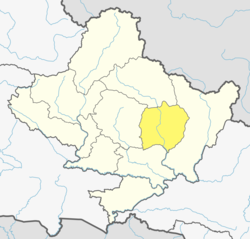| Lamjung District लमजुङ | |
|---|---|
| District | |
 | |
 Location of Lamjung (dark yellow) in Gandaki Province Location of Lamjung (dark yellow) in Gandaki Province | |
| Country | |
| Province | Gandaki Province |
| Admin HQ. | Besisahar |
| Government | |
| • Type | Coordination committee |
| • Body | DCC, Lamjung |
| Area | |
| • Total | 1,692 km (653 sq mi) |
| Population | |
| • Total | 167,728 |
| • Density | 99/km (260/sq mi) |
| Time zone | UTC+05:45 (NPT) |
| Telephone Code | 066 |
| Main Language(s) | Nepali, Gurung, Magar, Dura |
| Website | Official website |
Lamjung District (Nepali: लमजुङ जिल्ला [ˈlʌmd͡zuŋ] ), a part of Gandaki Province, is one of the 77 districts of Nepal. The district, with Besisahar as its district headquarters, covers an area of 1,692 square kilometres (653 sq mi) and as of 2011 had a population of 167,724. Lamjung lies in the mid-hills of Nepal spanning tropical to trans-Himalayan geo-ecological belts, including the geographical midpoint of the country (i.e., Duipipal). It has mixed habitation of casts and ethnicities. It is host to probably the highest density of the Gurung ethnic population in the country.
Popular Media in Lamjung Includes Mero Lamjung, Radio Chautari, Aantaranga Saptahik, Radio Marsyangdi,Radio Lamjung etc.
Geography and climate
| Climate Zone | Elevation Range | % of Area |
|---|---|---|
| Upper Tropical | 300 to 1,000 meters 1,000 to 3,300 ft. |
18.5% |
| Subtropical | 1,000 to 2,000 meters 3,300 to 6,600 ft. |
34.0% |
| Temperate | 2,000 to 3,000 meters 6,400 to 9,800 ft. |
20.3% |
| Subalpine | 3,000 to 4,000 meters 9,800 to 13,100 ft. |
14.1% |
| Alpine | 4,000 to 5,000 meters 13,100 to 16,400 ft. |
8.0% |
| Nival | above 5,000 meters | 3.6% |
| Trans-Himalayan | 3,000 to 6,400 meters 9,800 to 21,000 ft. |
1.3% |
Demographics

At the time of the 2011 Nepal census, Lamjung District had a population of 167,724.
As first language, 58.6% spoke Nepali, 29.9% Gurung, 6.6% Tamang, 1.8% Newari, 1.0% Dura, 0.8% Magar, 0.3% Urdu, 0.2% Bhojpuri, 0.1% Kumhali, 0.1% Maithili, 0.1% Yolmo, 0.1% Rai and 0.2% other languages.
Ethnicity/caste: 31.4% were Gurung, 15.9% Chhetri, 12.8% Hill Brahmin, 8.7% Kami, 7.3% Tamang, 5.3% Sarki, 3.9% Damai/Dholi, 3.7% Newar, 2.3% Gharti/Bhujel, 2.2% Magar, 1.9% Dura, 1.0% Kumal, 0.9% Thakuri, 0.8% Sanyasi/Dasnami, 0.6% Musalman, 0.2% Rai, 0.1% Gaine, 0.1% Ghale, 0.1% Khawas, 0.1% Majhi, 0.1% Tharu, 0.1% Yolmo and 0.3% others.
Religion: 64.0% were Hindu, 33.1% Buddhist, 1.8% Christian, 0.6% Muslim and 0.4% others.
Literacy: 70.8% could read and write, 2.5% could only read and 26.6% could neither read nor write.
| Census year | Pop. | ±% p.a. | ||
|---|---|---|---|---|
| 1981 | 152,720 | — | ||
| 1991 | 153,697 | +0.06% | ||
| 2001 | 177,149 | +1.43% | ||
| 2011 | 167,724 | −0.55% | ||
| 2021 | 153,480 | −0.88% | ||
| ||||
| Source: Citypopulation | ||||
Rural municipalities and municipalities
- Besisahar Municipality
- Dordi Rural Municipality
- Dudhpokhari Rural Municipality
- Kwhlosothar Rural Municipality
- Madhya Nepal Municipality
- Marsyandi Rural Municipality
- Rainas Municipality
- Sundarbazar Municipality
2015 earthquake
The epicentre of an earthquake on 25 April 2015 was near Lamjung District that is Barpak of Gorkha district. Most of the major damage and casualties took place in nearby Kathmandu, Nepal's capital. The death toll was placed at over 8,800. However, only four deaths were reported in Lamjung District.
While Lamjung was the district with the 20th most deaths in Nepal, it was severely damaged. The villages of Bichaur, Ilampokhari, Dudhpokhari, Gauda, Kolki and Pyarjung were the most affected. Assistant Sub Inspector Bir Bahadur Thapa Magar identified the four deaths in Lamjung District as Lakshmi Gurung, 18, of Ilampokhari village; Nepti Tamang, 91, of Gaudu village; Sher Bahadur Tamang, 62, of Gaudu village; and three-and-a-half-month-old Sumit Bika of Gauda village. Twenty-five people were injured in Lamjung District. Local police estimate 2,094 houses were completely destroyed while another 2,129 houses were partially damaged.
References
- ^ "National Population and Housing Census 2011(National Report)" (PDF). Central Bureau of Statistics. Government of Nepal. November 2012. Archived from the original (PDF) on 2013-04-18. Retrieved 19 June 2015.
- The Map of Potential Vegetation of Nepal — a forestry/agroecological/biodiversity classification system (PDF), Forest & Landscape Development and Environment Series 2-2005 and CFC-TIS Document Series No.110., 2005, ISBN 87-7903-210-9, retrieved Nov 22, 2013
- NepalMap Language
- NepalMap Caste
- NepalMap Religion
- NepalMap Literacy
- "NEPAL: Administrative Division". www.citypopulation.de.
- "Map of the earthquake M7.9 – 29km ESE of Lamjung, Nepal". Global Earthquake Epicenters with Maps. Geographic.org. Retrieved 25 April 2015.
- Barry, Ellen (25 April 2015). "Strong Earthquake Strikes Nepal Near Its Capital, Katmandu". The New York Times. Retrieved 25 April 2015.
- Khan, Hamza (1 May 2015). "Nepal Earthquake: Death toll crosses 5,000, but only 4 die at epicentre". The Indian Express. Archived from the original on 1 May 2015. Retrieved 1 May 2015.
- "Districts of Nepal". Statoids.
| Provinces and Districts of Nepal | ||
|---|---|---|
| Koshi | ||
| Madhesh | ||
| Bagmati | ||
| Gandaki | ||
| Lumbini | ||
| Karnali | ||
| Sudurpashchim | ||
28°14′N 82°25′E / 28.233°N 82.417°E / 28.233; 82.417
Categories: